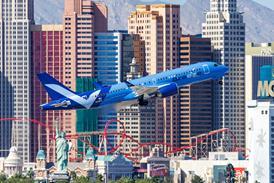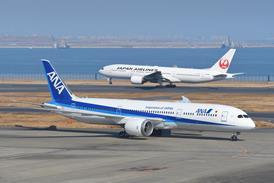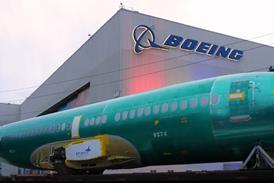The past decade has not been kind to Kuwait's flag carrier. Now, with the overthrow of Saddam Hussein, it knows the onus of reform rests squarely on its own shoulders
The pursuit of profitability by Kuwait Airways (KAC) has so far not achieved anywhere near the desired results. However, even the most jaded cynic would have to admit that the state-owned flag carrier's proximity to Iraq brought with it problems not easily overcome. But now that closeness to Iraq looks more and more like an asset, meaning that the only thing separating KAC from financial success is an ability to undertake meaningful reform.
Most agree with airline chairman and managing director Ahmed Al-Zabin when he says that the carrier's biggest difficulty in recent years has been its "crazy neighbour" next door, a problem that began when Iraq invaded Kuwait in 1991, kicking off the first Gulf War.
Al-Zabin explains that the airline, which will mark its 50th year in 2004, is still struggling to overcome the effects of the invasion. The fighting and subsequent theft by the Iraqi invaders cost KAC 86% of its asset base, requiring it to completely replace its fleet and turn to the government for a cash infusion of 400 million Kuwaiti dinars ($1.3 billion).
The following 12 years, while not as cataclysmic, also exacted a heavy toll. The closing of the airways over Iraq has meant that all flights between Kuwait City and destinations in Europe and the USA assume a circuity penalty, adding on to the fuel and payroll bill and lowering the utilisation levels of its largest aircraft.
More importantly it also adversely affected passenger levels. Al-Zabin says that regional insecurity made the prospect of connecting through Kuwait unpopular. This is particularly damaging to the home carrier, which relies on transfer passengers for 50-55% of its traffic, and most of its passengers outside the summer season, when Kuwaitis holiday abroad en masse. At times, it had been completely disastrous, such as in 1998 when Iraq massed troops on the border, decimating connecting traffic levels for months.
Now, however, with the overthrow of Saddam Hussein, the airline believes its close proximity to Iraq will be a blessing. Al-Zabin anticipates that in addition to passenger increases - both originating and connecting - that regional stability will jump start, KAC will get a hefty share of the business and cargo traffic that the reconstruction of Iraq will promote.
He adds that the airline, which operated the first relief flight to Baghdad after the fall of the Saddam regime, is set to enjoy a geographic advantage in serving the oil fields in the south of Iraq, as well as Basra, the country's second city, which is only 150km from Kuwait City.
The chairman is quick to admit, however, that the troubles of his loss-making carrier cannot all be laid at the feet of Saddam Hussein, nor will the end of his regime be a panacea. The airline has for years been inefficient and still has many problems left to tackle. This is evidenced by the carrier posting an average annual loss of more than 37 million dinars over the last 5 years, something that appears to owe as much to interference by the government of Kuwait as by that of Iraq.
Local hires
The biggest factor has been the policy instituted after the first Gulf war requiring the flag carrier to hire almost exclusively Kuwaiti nationals, especially for non-flight crew positions. Al-Zabin says that this move has had direct impact on both company expenditure - it costs over three times as much to hire a Kuwaiti citizen as a foreigner doing the same job - and productivity.
Because the skills required to work in the airline industry were largely absent from the national workforce, implementing the policy requires a lengthy training programme. The chairman estimates that it takes seven years from the time a novice joins the carrier until the time he is able to contribute meaningfully. "It's an investment," Al-Zabin says, "but it's also a burden."
The government has also hindered the airline's attempts to get its workforce down to a reasonable level. A study conducted in 1998 by consultants SH&E noted that, at 5,600 employees, the carrier was at least 20% overstaffed. Since then, the carrier has used voluntary retirement and attrition measures to reach the 4,900 mark, but much plainly remains to be done.
Head of human resources Lafi Al-Dhafiri says that "there is still a lot of fat, especially within the administrative ranks". He believes that the optimal headcount would be around 3,000, but admits that political pressures make attaining this goal unlikely, at best.
It is largely because of such mandates that Al-Zabin believes the carrier can only become profitable if it is allowed to operate with autonomy, preferably as a private concern. "Privatisation is the solution that will take us from red to black," he says.
The chairman's belief in the potential profitability of his carrier is driven by several factors. These include the wealth and price-insensitive travel habits of Kuwait's 1.25 million nationals, the business traffic generated by its petroleum industry and the air travel patterns of a large guest worker population.
He says that KAC's safety record is also a draw. In a region that has had several high-profile air disasters, it has never had a fatal crash. In part because of the carrier's demonstrated commitment to operational and maintenance integrity, Al-Zabin was recently appointed president of the UK-based International Federation of Airworthiness.
Kuwait's location is also a boon, both for east-west flying, and as a central point within the Middle East region. The carrier's intra-regional flights represent its most lucrative routes. It is for reasons such as these, the chairman says, that a privatised KAC could be profitable within three to four years.
However, he adds, although the government supports privatisation in principle - and has even proposed a multi-sector privatisation programme - it has more immediate priorities to address and is not likely to take action any time soon. Indeed, the master privatisation proposal has been awaiting parliamentary approval since 1996.
Not content to wait idly for the carrier's sale to be authorised, Al-Zabin has taken positive steps toward reform. This process has included recording higher aircraft utilisation rates - he notes that KAC now carries more passengers on a smaller fleet than before the first Gulf War - and initiating an assessment centre that will enable the carrier to measure individual employee productivity.
More ambitious are the liberalisation projects that KAC has inititated to circumvent its high cost base. For instance, it has outsourced the maintenance of the Oasis Club loyalty programme as well as the on-board sale of duty free goods. Even more telling are plans to spin off several activities not related to the core activity of long-haul flying, including the maintenance function, as well as dedicated cargo carriage and intra-regional service.
New enterprises
As regards the cargo and regional initiatives, Al-Zabin recognises that both activities are potentially quite profitable, but thinks the KAC cost structure would make them money losers. "Our overheads are just too big," he concedes.
In view of this, the carrier has proposed to the Kuwaiti Council of Ministers the creation of two separate new airlines, one a cargo carrier, the other a regional. KAC would have a 20-24% stake in each, with the remainder to be divided between the local private sector and strategic partners, quite likely other airlines.
The cargo carrier proposal includes the purchase of two 30-40 tonne aircraft, while the regional plan envisages three regional aircraft, to increase to six within three years. Al-Zabin notes, however, that both proposals, for which he expects a government response shortly, were submitted before the fall of the Saddam regime. The new situation, he says, may justify a higher level of fleet investment.
The regional carrier would operate either turboprops or regional jets - small size is the key, says Al-Zabin - and would connect Kuwait with destinations in Iraq, Iran and elsewhere in the Gulf region. KAC is counting on profits from its stake in the company, to which it will hand over some of the routes it currently serves, as well as increased feed at its hub. In any event, it will aim to not repeat the experience of Shorouk Airways, the Cairo-based regional airline it founded in 1991 with EgyptAir.
Shorouk, in which the carrier has a 49% stake, has long struggled and took $27 million out of KAC's coffers last year. Al-Zabin chalks up the carrier's poor performance to a combination of poor management and bad timing, citing the drop in tourism numbers caused by Egyptian terrorism and 11 September. He admits that "at this late stage, it will be very difficult to put it back on its feet".
With a new sense of regional stability and numerous reform efforts under way, Al-Zabin plainly does not feel the same is true for Kuwait Airways. n
REPORT BY RICHARD PINKHAM IN KUWAIT CITY
Source: Airline Business























